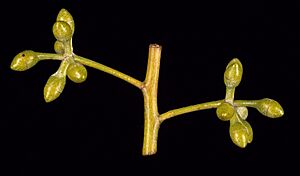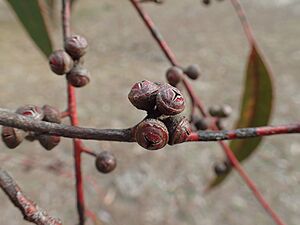Bendemeer white gum facts for kids
Quick facts for kids Bendemeer white gum |
|
|---|---|
 |
|
| Eucalyptus elliptica growing west of Walcha | |
| Scientific classification | |
| Genus: |
Eucalyptus
|
| Species: |
elliptica
|
| Synonyms | |
|
|
The Bendemeer white gum (scientific name: Eucalyptus elliptica) is a special kind of tree. It's a small to medium-sized tree. You can only find it naturally in eastern Australia. This means it's endemic there. It has smooth bark, long leaves, and white flowers. Its fruit looks like a small cup.
Contents
What Does the Bendemeer White Gum Look Like?
The Bendemeer white gum is a tree that usually grows up to 20 meters (about 65 feet) tall. It has a special woody swelling at its base called a lignotuber. This helps the tree regrow after a fire.
Its bark is smooth and often powdery white. It can also have orange or grey patches.
Leaves of the Bendemeer White Gum
Young plants have different leaves than older ones. Their leaves are egg-shaped to almost round. They are arranged in opposite pairs along the stem. These young leaves are also glaucous, which means they have a dull, bluish-green color. They are sessile, meaning they attach directly to the stem without a stalk. These leaves are about 20 to 100 mm long and 20 to 60 mm wide.
Adult leaves are green or bluish-green on both sides. They are shaped like a spear or slightly curved. They grow to be about 70 to 200 mm long and 13 to 30 mm wide.
Flowers and Fruit
The flowers of the Bendemeer white gum are white. They grow in groups of seven. These groups appear in the axils of the leaves. An axil is the angle between a leaf and the stem.
Each group of flowers grows on a stalk called a peduncle. This peduncle is 4 to 17 mm long. The individual flower buds sit on smaller stalks called pedicels, which are 1 to 5 mm long.
Mature flower buds are oval-shaped. They are about 5 to 8 mm long and 3 to 4 mm wide. Each bud has a cone-shaped cap called an operculum. This cap falls off when the flower opens.
After the flowers bloom, they turn into fruit. The fruit is a woody capsule. It looks like a cup or half a sphere. These capsules are 4 to 6 mm long and 5 to 8 mm wide. The parts that release the seeds stick out above the rim of the fruit.
How It Got Its Name
The Bendemeer white gum was first officially described in 1934. This was done by two botanists, William Blakely and Ernest Norman McKie. They found a sample of the tree near a place called Bendemeer.
They first named it E. mannifera var. elliptica. This description was published in Blakely's book, A Key to the Eucalypts.
Later, in 1990, two other botanists, Lawrie Johnson and Ken Hill, changed its status. They decided it was a full species and named it E. elliptica.
The second part of its scientific name, elliptica, refers to the shape of its fruit. Blakely and McKie described the fruit as being elliptical, or oval-shaped.
Where Does It Live?
The Bendemeer white gum grows in grassy woodlands. You can find it in eastern Australia. Its range stretches from the Barrington Tops area in New South Wales up to southeastern Queensland. It is most commonly found around the Bendemeer and Walcha areas.



